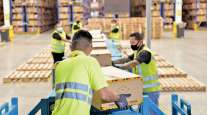Special to Transport Topics
Increase in Online Shopping Spurs Innovation for Shipping Packaging

[Stay on top of transportation news: Get TTNews in your inbox.]
Effective shipment packaging relies as much on science and engineering as it does diligence and common sense. Matching the right box for the product and properly securing palletized shipments is crucial in the physically challenging environment of a less-than-truckload or parcel network.
That’s a viewpoint shared by many across the industry as innovations in packaging material design, testing and application help prevent cargo damage. These efforts are refining decades-old dock operations, trailer load planning and material handling practices to improve how goods are prepped, loaded and secured for transit.
The inexorable growth of e-commerce shipments has created new challenges for how product packaging is designed and how goods are secured to endure the rigors of shipping, said Laszlo Horvath, associate professor and director of Virginia Tech’s Center for Packaging and Unit Load Design.

Horvath
“There is a huge buzz over e-commerce; everyone is trying different approaches [to packaging],” he said.
One example he cited is bottled laundry detergent.
Previously, detergent bottles were designed to ship on pallets in large, stacked quantities to stores, where they’d then go onto the shelf for consumers to buy. Consumers essentially acted as their own last-mile delivery provider.
But with the stay-at-home orders and social distancing guidelines implemented during the coronavirus pandemic, store visits dropped, and those detergent bottles that once traveled as palletized unit loads now were being shipped one or two at a time in a cardboard box through an e-commerce channel.
In this environment, the traditional bottle and cap design developed leakage issues, Horvath said. As a result, some manufacturers designed a plastic bottle cap with a better seal to withstand e-commerce shipping, while others used a more holistic approach, redesigning their detergent packaging using a corrugated box design as the base so it could be used for shipping. Another manufacturer of fabric softener doubled the concentration of the product, which allowed it to replace a 120-ounce bottle with a smaller yet sturdier 80-ounce bottle.
Shipment packaging must be designed to protect the product from the unexpected, not just what it would encounter in a perfect world, said Chris Kelley, vice president for the central states region at Old Dominion Freight Line.
“Ideally, if nothing ever touched the product, the display packaging would [arrive] fine,” he said, but in an LTL environment, there are many factors that can potentially affect how a shipment is riding in the trailer.
ODFL, with a claims ratio of less than 0.05%, does as good a job as any of properly loading, blocking and bracing freight, Kelley said, but as trucks travel down the highway, accidents do happen.
Road and weather conditions, congestion, starts and stops, and driver reactions to potential safety hazards all are part of the journey, and all can cause jostling and the potential for freight in the trailer to shift.
ODFL, based in Thomasville, N.C., ranks No. 8 on the Transport Topics Top 100 list of the largest for-hire carriers in North America.
LTL carriers also must contend with a wide range of freight. A pallet of Barbie dolls with their pristine, shelf-ready display packaging may be traveling alongside dozens of other consumer and industrial goods, and could be sitting next to, for example, a 2,000-pound crated piece of machinery.
Proper load planning and loading technique, coupled with effective bracing, blocking and use of dunnage, is essential, Kelley said.
He offers suggestions for shippers to properly prepare shipments for transit and avoid claims: Make sure the outside packaging complements and is right-sized for what’s inside.
With the rise in e-commerce and the emphasis on order velocity, some companies are using a one-size-fits-all box, Kelley said. “If there is void inside that’s not properly filled, that reduces the strength [of the box].”
That makes the shipment more susceptible to damage, he said, adding that the crushing of the outer package occurs because the product inside doesn’t fill out the space.

The massive influx of e-commerce-ordered and shipped goods has created new challenges for how product packaging is designed. (PECO Pallet)
Pallet build is another key factor. Pallets stacked too high, or with cargo too heavy for the pallet, or with different-sized boxes that are incompatible, can diminish the strength integrity of the overall shipment, Kelley said.
“Consistent, tight pallet-builds that are constructed well and use proper shrink-wrapping are one of the most effective practices shippers can do to protect freight,” he said. “You have to account for the G-forces in the trailer.”
Pat Martin, corporate vice president of sales for Estes Express Lines, contends that fleets should spend more time with their customers on shipment packaging.
Similar to other LTL carriers, Estes Express is proactive with shippers.
“[We’re] sending out folks to look at how product is packaged and prepped, making recommendations to ensure goods are secure and properly protected,” Martin said.
The National Motor Freight Classification guidelines are a key reference, he said.
“[Aligning with the NMFC] is where it starts for us,” Martin said. “Make sure you are using the correct box with the correct bursting strength.”
One positive trend Martin cited is the rise of new technologies that are helping box manufacturers and shippers quickly build custom-fit boxes more precisely to the product, versus using generic-sized boxes and then filling voids with dunnage.
He also pointed to increasing adoption by large e-commerce shippers of systems that measure the dimension and weight of the product coming down the conveyor, custom-build the box to fit and insert the product, then automatically tape it. While it can be more expensive than generic boxes, Martin believes that ultimately the total cost is equal or less because of labor and material savings and throughput gains.
Nevertheless, the nature of the business means that claims do happen.
“If freight is damaged and it’s our fault, we’ll own up to it,” Martin said. “We’ll also examine our processes internally, find the root cause of a problem, and then make adjustments to correct it.”
Estes Express, based in Richmond, Va., ranks No. 13 on the TT100 list of for-hire carriers.

Rivera
Jeff Rivera, chief operating officer and president of western U.S. operations at Lineage Logistics, the largest operator of refrigerated warehousing in the United States, sees a continued drive toward more sustainable packaging through dunnage that is more reusable and recyclable.
“Before it was Styrofoam going into a landfill. Now it’s a biodegradable material. You pour water on it and it melts,” he said.
Rivera also cited innovations such as shipment packaging designed for multiple uses. One Lineage customer, an e-commerce site that sells fresh protein products, ships its orders in a multiuse container that once unpacked, does double duty.
“It’s sturdy enough and creatively designed such that it can be repurposed as a [portable] beverage cooler, or as a storage box,” he said. “It’s well thought-out and does a good job protecting the product.”
An often overlooked yet important variable in the shipment integrity equation is the pallet. It’s an area where shippers may think they can skimp — at their own peril, said Virginia Tech’s Horvath.
“People are buying more cheaper, lower quality pallets and expect them to be safe,” he said. “That runs a higher risk [of failure]. If you put your product on a weak pallet it will get damaged in shipment.”
Horvath also cited two other common mistakes shippers make: using poor-quality packing tape or an incorrect or inefficient use of stretch wrap. For businesses with a relatively high volume of shipping, he recommended investing in automated stretch wrap machines.
“Adding a semi-automated stretch wrap machine into the line can increase film utilization [as much as] 300%,” he said. “That cuts costs and, if applied correctly, creates more consistency and better strength.”
Joe Dagnese, CEO atPECO Pallet, which operates one of North America’s largest pallet rental networks, echoed Horvath’s observation.
“Pallet integrity is the foundation of a successful, damage-free shipment,” he said. “It matters little how well the products are packaged or the load shrink-wrapped — if the pallet fails the entire shipment is put at risk.”
PECO’s pallet rental network has some 2,100 pallet recovery locations, including 42 full-service depots and 44 sort facilities in the U.S. and Canada. As pallets are returned, they undergo inspection and repair processes before being reintroduced to the market.

Smith
Designing cost-effective packaging solutions that meet goals for protecting goods in transit is a function of three variables: packing cost, material cost and labor cost, said Dustin Smith, co-founder and CEO of BoldtSmith Packaging Consultants.
“It’s an engineering quest,” he said.
It’s imperative to know what forces are affecting the product and both its display packaging and shipment packaging, and then build a solution that can withstand those forces. Smith tells shippers to start with three basic guidelines as best practices: Understand the needs and realities of your supply chain, design packaging to survive the supply chain, and then test and verify.
Box manufacturers can also be a valuable resource for shippers.

Kenyon
“They will know the right questions to ask, and the performance specifications the packaging needs to meet,” said Rachel Kenyon, senior vice president of the Fibre Box Association, a trade group representing corrugated packaging manufacturers.
She stressed the importance of — and differences between — primary and transport packaging.
“Tell your manufacturer what type of primary packaging you are working with. Is it rigid? Can it support some of the weight of the shipment?” Kenyon said. “How many units are you trying to get in a box? All of those things play into the solution and affect transport packaging.”
Want more news? Listen to today's daily briefing below or go here for more info:




